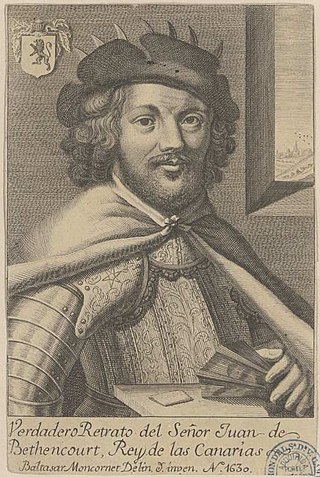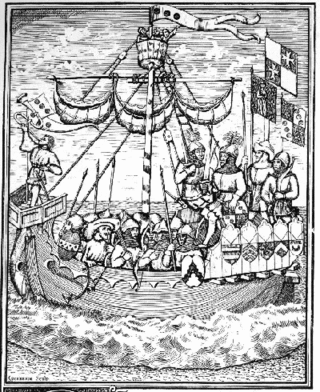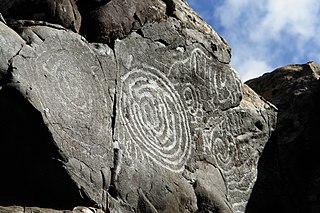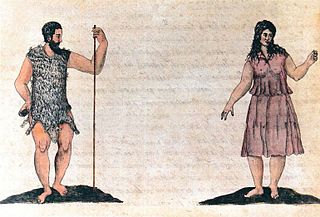
The Canary Islands, also known informally as the Canaries, are a Spanish autonomous community and archipelago in Macaronesia in the Atlantic Ocean. At their closest point to the African mainland, they are 100 kilometres west of Morocco and the Western Sahara. They are the southernmost of the autonomous communities of Spain. The islands have a population of 2.2 million people and are the most populous special territory of the European Union.

The Guanche were the historic indigenous inhabitants of the Canary Islands in the Atlantic Ocean some 100 kilometres (60 mi) west of the North African coast. They spoke the Guanche language. Believed to have been related to Berber languages of North Africa, it became extinct in the 17th century after the islands were colonized.

Lanzarote is a Spanish island, the easternmost of the Canary Islands in the Atlantic Ocean, 125 kilometres off the north coast of Africa and 1,000 kilometres from the Iberian Peninsula. Covering 845.92 square kilometres, Lanzarote is the fourth-largest of the islands in the archipelago. With 158,798 inhabitants at the start of 2023, it is the third most populous Canary Island, after Tenerife and Gran Canaria. Located in the centre-west of the island is Timanfaya National Park, one of its main attractions. The island was declared a biosphere reserve by UNESCO in 1993. The island's capital is Arrecife, which lies on the eastern coastline. It is the smaller main island of the Province of Las Palmas.

Jean de Béthencourt was a French explorer who in 1402 led an expedition to the Canary Islands, landing first on the north side of Lanzarote. From there he conquered for Castile the islands of Fuerteventura (1405) and El Hierro, ousting their local chieftains. Béthencourt received the title King of the Canary Islands but he recognized King Henry III of Castile, who had provided aid during the conquest, as his overlord.

Alonso Fernández de Lugo was a Spanish military man, conquistador, city founder, and administrator. He conquered the islands of La Palma (1492–1493) and Tenerife (1494–1496) for the Castilian Crown; they were the last of the Canary Islands to be conquered by Europeans. He was also the founder of the towns of San Cristóbal de La Laguna, Santa Cruz de Tenerife and Santa Cruz de La Palma. One biographer has written that his personality was a “terrible mixture of cruelty and ambition or greed, on one part, and on the other a great capacity and sense for imposing order and government on conquered lands,” a trait found in the conquistadors of the New World.

Lancelotto Malocello was an Italian navigator, citizen of the Republic of Genoa, who gave his name to the island of Lanzarote, one of the Canary Islands. Lancelotto is the Italian form of the proper name Lancelot.

Gadifer de La Salle was a French knight and crusader of Poitevine origin who, with Jean de Béthencourt, conquered and explored the Canary Islands for the Kingdom of Castile.

The Canary Islands have been known since antiquity. Until the Spanish colonization between 1402 and 1496, the Canaries were populated by an indigenous population, whose origin was Amazigh from North Africa.
Canary Islanders, or Canarians, are the people of the Canary Islands, an autonomous community of Spain near the coast of northwest Africa. The distinctive variety of the Spanish language spoken in the region is known as habla canaria or the (dialecto) canario. The Canarians, and their descendants, played a major role during the conquest, colonization, and eventual independence movements of various countries in Latin America. Their ethnic and cultural presence is most palpable in the countries of Uruguay, Venezuela, Cuba and the Dominican Republic as well as the U.S. territory of Puerto Rico.

Juan Rejón was an Aragonese captain in the service of the Castilian navy, who was appointed by the Catholic Monarchs to participate in the conquest of the Canary Islands. Rejón founded the city of Las Palmas de Gran Canaria.

The Diocese of San Cristóbal de La Laguna, also called Diocese of Tenerife or Diocese Nivariense, is a diocese located in the city of San Cristóbal de La Laguna in the Canary Islands and a suffragan in the ecclesiastical province of the Archdiocese of Sevilla in Spain. The diocese includes the islands of Tenerife, La Palma, La Gomera and El Hierro, in the province of Santa Cruz de Tenerife. The bishop of this diocese is Bernardo Álvarez Afonso.
The Battle of Aguere, or Battle of San Cristóbal de La Laguna, was fought between forces of the Crown of Castile, led by the Adelantado Alonso Fernández de Lugo, and the natives of Tenerife, called Guanches. The battle took place on 14-15 November 1494.

The conquest of the Canary Islands by the Crown of Castile took place between 1402 and 1496 and described as the first instance of European settler colonialism in Africa. It can be divided into two periods: the Conquista señorial, carried out by Castilian nobility in exchange for a covenant of allegiance to the crown, and the Conquista realenga, carried out by the Spanish crown itself, during the reign of the Catholic Monarchs.

Tinerfe "the Great", legendary hero who was a guanche mencey of the island of Tenerife. It is estimated that he lived at the end of the 14th century.

Bimbache or Bimbape is the name given to the inhabitants of El Hierro, who inhabited the island before the Spanish conquest of the Canary Islands that took place between 1402 and 1496. The Bimbache are one of several peoples native to the Canaries, with a genetic and cultural link to the Berber people of North Africa. The Bimbache people shared a common link with other aboriginal peoples of the Canary Islands.
As in the rest of Spain, the majority religion in the Canary Islands is the Catholic Church. The Catholic religion has been the majority since the Conquest of the Canary Islands in the fifteenth century. This religion would largely replace the Canarian aboriginal religion through the prohibition of the latter and syncretism. According to a survey conducted in 2019, Canary Islands is the fifth autonomous community in Spain with the highest percentage of people who declare themselves to be Catholics after the Region of Murcia, Extremadura, Galicia, Aragon, and Castile and León. 76.7% of the population is Catholic.
Hernán Peraza Martel also known as Hernán/Fernán Peraza the Elder , was a Castilian nobleman and Conquistador, and the territorial lord of the Canary Islands in the fifteenth century.
Inés Peraza de las Casas was the territorial lady of the Canary Islands, which she inherited from her father Hernán Peraza the Elder and her late brother Guillén Peraza.
The Peraza family was a Castilian noble family of conquistadors, territorial lords, counts, and governors that were a significant force in the history and conquest of the Canary Islands during the Age of Discovery in the fifteenth and sixteenth centuries.
Perdomo, is a Canary Islander noble family name originally from Normandy, France. The surname Perdomo is a Spanish version of the French surname Prudhomme, and is closely associated with the Bethencourt family of France. "Prudhomme" was a French term meaning a good or wise man used in the Middle Ages to designate local magistrates.
















